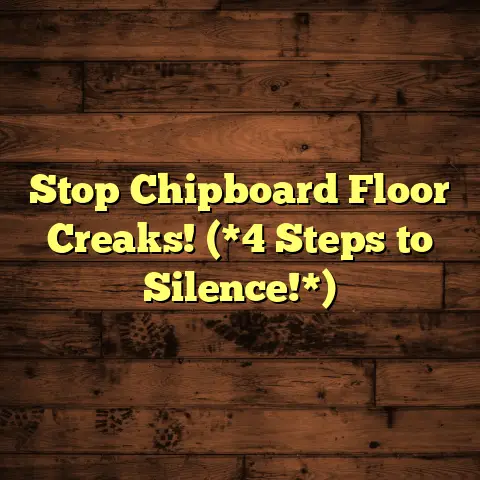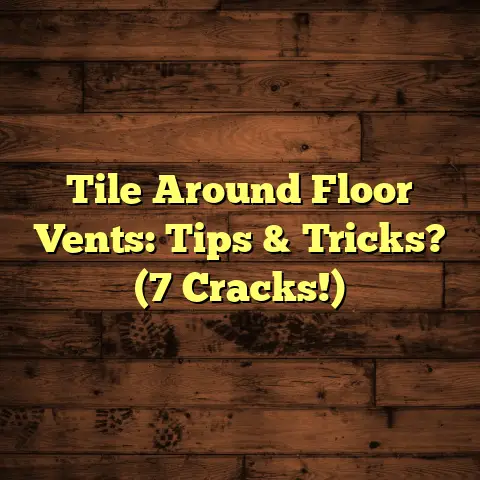Why Do Floors Creak? (5 Fixes Now!)
Imagine this: it’s late at night, the world outside is shrouded in darkness, and you’re alone in your home.
Suddenly, a bone-chilling sound slices through
the silence—a creak beneath your feet.
Is it
just the house settling, or is something more
sinister at play?
The haunting echoes of your floorboards may awaken your curiosity and concern, leading you to wonder: why do floors creak?
And trust me, you’re not alone!
In this
article, we will delve into the mysteries behind
this unsettling phenomenon and equip you with
five effective fixes to silence those eerie
sounds once and for all.
Understanding the Science of Creaking Floors
Ever wondered what makes your floors tick… or rather, creak?
It’s not just some random noise; there’s actual
science at play.
Let’s break it down.
Floorboards, whether they’re hardwood, engineered wood, or even subflooring, are constructed from materials that react to their environment.
Think of wood like a sponge.
It absorbs moisture
from the air when it’s humid and releases it
when it’s dry.
Temperature and humidity changes are major
culprits.
When humidity rises, wood expands,
and when it drops, it contracts.
This movement can cause floorboards to rub against each other, against nails, or against the subfloor, leading to those dreaded creaks.
Imagine a perfectly fitted puzzle.
Now imagine
the pieces slightly expanding and contracting.
They’ll start to grind against each other, right?
That’s essentially what’s happening with your floors.
The Impact of Age and Wear:
Age and wear also play a significant role.
Over
time, the fasteners holding your floorboards in
place can loosen.
The wood itself can warp or become damaged, further contributing to movement and noise.
Think about it – your floors endure a lot!
Foot
traffic, furniture, spills, and the constant
shifting of the house itself all take their toll.
The Effects of House Settling and Structural Shifts:
House settling is another factor.
As your house
ages, it naturally settles into the ground.
This settling can cause slight shifts in the foundation and framing, which can put stress on your floors.
Structural shifts, while less common, can also
contribute to creaking.
These shifts can be
caused by things like soil erosion, poor
construction, or even seismic activity.
I once worked on a house where a slow leak in
the foundation caused significant settling on one
side.
The floors throughout the entire house
were creaking like crazy!
Key Takeaway:
So, the next time you hear a creak, remember
it’s not just a ghost in the attic.
It’s a
combination of material science, environmental
factors, and good old-fashioned wear and tear.
Common Causes of Creaking Floors
Alright, now that we understand the science, let’s dive into the specific reasons why your floors might be singing (or rather, creaking) a less-than-pleasant tune.
Loose Floorboards:
This is probably the most common cause.
Over
time, nails or screws can loosen, allowing the
floorboards to move independently.
When you step on a loose board, it rubs against the surrounding boards or the subfloor, creating that telltale creak.
I’ve seen cases where entire sections of flooring were practically floating because so many fasteners had come loose!
Friction Between Materials:
Friction is the enemy of silence.
When wood rubs
against wood, or when nails rub against wood, it
creates noise.
Think of it like rubbing two pieces of sandpaper
together.
The rough surfaces create friction and
noise.
The same principle applies to your floors.
Improper Installation:
A bad install can haunt you for years to come.
Gaps between boards, insufficient nailing, or an
uneven subfloor can all lead to creaking.
I’ve seen DIY projects gone wrong where the homeowner used the wrong type of fasteners or didn’t properly prepare the subfloor.
The result? A symphony of creaks with every step.
Environmental Factors:
As we discussed, humidity and temperature fluctuations can wreak havoc on your floors.
Excessive moisture can cause wood to swell,
leading to buckling and creaking.
Conversely,
dry conditions can cause wood to shrink, creating
gaps and looseness.
I always advise clients to maintain a stable
indoor environment to minimize these effects.
A
dehumidifier in the summer and a humidifier in
the winter can make a big difference.
Pest Infestations:
Okay, this one is less common, but it’s worth
mentioning.
Certain pests, like termites or
carpenter ants, can burrow into your subfloor or
floorboards, weakening the structure and
creating noise.
If you suspect a pest infestation, it’s crucial to call a professional exterminator immediately.
Here’s a quick rundown in a table:
My Personal Take:
In my experience, loose floorboards and
environmental factors are the most frequent
culprits.
But it’s always important to consider
all the possibilities when diagnosing a creaky
floor.
Five Effective Fixes for Creaking Floors
Alright, let’s get down to brass tacks.
You’ve
identified the source of the creak, now what?
Here are five proven fixes I’ve used countless times to silence those noisy floors.
Fix #1: Tightening Loose Floorboards
This is often the first and easiest solution. Here’s how to do it:
Step 1: Locate the Creak: Walk around the area and pinpoint the exact location of the creak.
Press down on the floorboards to see which ones move or flex.Step 2: Choose Your Fastener: For hardwood floors, I typically recommend using screws rather than nails.
Screws provide a stronger, more secure hold.
Choose screws that are long enough to penetrate the subfloor but not so long that they go all the way through.Step 3: Pre-Drill a Pilot Hole: This is crucial, especially with hardwood.
Pre-drilling prevents the wood from splitting and makes it easier to drive the screw in straight.Step 4: Drive in the Screw: Use a screwdriver or drill to drive the screw in until it’s flush with the surface of the floorboard.
Don’t overtighten, as this can strip the screw or damage the wood.-
Step 5: Countersink and Fill (Optional): If you want a seamless look, you can countersink the screw slightly and fill the hole with wood filler that matches the color of your floor.
Tools and Materials Needed:
- Screwdriver or drill
- Wood screws (appropriate size and type)
- Drill bit (for pilot hole)
- Wood filler (optional)
- Countersink bit (optional)
Pro Tip: If you’re working with old, brittle
wood, be extra careful when pre-drilling and
driving in screws.
You might even want to apply
a bit of wood glue to the screw threads for added
hold.
Fix #2: Applying Powdered Graphite or Talcum Powder
This is a simple but surprisingly effective fix for minor creaks caused by friction between floorboards.
-
Step 1: Locate the Creak: Again, pinpoint the exact location of the noise.
-
Step 2: Apply the Powder: Use a small squeeze bottle or a powder duster to apply the powdered graphite or talcum powder into the gaps between the floorboards.
-
Step 3: Work it In: Use a soft brush or your fingers to gently work the powder into the gaps.
-
Step 4: Clean Up: Wipe away any excess powder from the surface of the floor.
How it Works:
The powder acts as a lubricant, reducing friction between the boards and silencing the creak.
I’ve used this trick on countless occasions, and it often works like a charm, especially for those annoying little squeaks.
Fix #3: Using Wood Glue or Construction Adhesive
This fix is ideal for loose floorboards that are slightly warped or have small gaps underneath.
-
Step 1: Identify the Loose Area: Find the exact spot where the floorboard is loose.
-
Step 2: Clean the Area: Remove any dirt, dust, or debris from the gap beneath the floorboard.
-
Step 3: Apply the Adhesive: Use a caulking gun or a small applicator to apply a bead of wood glue or construction adhesive into the gap.
-
Step 4: Weigh it Down: Place a heavy object (like a stack of books or a dumbbell) on top of the floorboard to hold it in place while the adhesive dries.
-
Step 5: Allow to Dry: Allow the adhesive to dry completely according to the manufacturer’s instructions (usually 24-48 hours).
Safety Precautions:
- Always wear gloves when working with adhesives.
- Work in a well-ventilated area.
- Follow the manufacturer’s instructions carefully.
Fix #4: Installing Additional Fasteners
Sometimes, simply tightening existing fasteners
isn’t enough.
In these cases, you may need to
install additional screws or nails.
-
Step 1: Locate the Creak: Find the area where the floor is creaking and identify the loose boards.
Step 2: Choose Your Fastener: As I mentioned earlier, screws are generally better than nails for a more secure hold.
Choose screws that are long enough to penetrate the subfloor but not too long that they go all the way through.-
Step 3: Pre-Drill Pilot Holes: This is essential to prevent the wood from splitting.
-
Step 4: Drive in the Fasteners: Drive in the screws or nails at an angle to the floorboards for maximum holding power.
-
Step 5: Countersink and Fill (Optional): If desired, countersink the fasteners and fill the holes with wood filler.
Tips for Ensuring a Secure Fix:
- Stagger the fasteners to distribute the load evenly.
- Use a stud finder to locate the floor joists
beneath the subfloor.
Fastening into the joists will provide a much stronger hold. - Don’t overtighten the fasteners, as this can damage the wood.
Fix #5: Floor Joist Reinforcements
If your floors are creaking due to weak or
sagging floor joists, you may need to reinforce
them.
This is a more involved project, but it
can make a huge difference.
-
Step 1: Inspect the Joists: Access the joists from below (usually in a basement or crawl space) and inspect them for signs of damage, such as cracks, rot, or sagging.
-
Step 2: Add Blocking: Blocking involves installing short pieces of wood between the joists to provide additional support and prevent them from twisting.
Step 3: Sistering Joists: Sistering involves attaching a new joist alongside the existing one to strengthen it.
This is a common solution for sagging or damaged joists.-
Step 4: Secure the Reinforcements: Use construction adhesive and screws to securely attach the blocking or sister joists to the existing joists.
A Detailed Process for Adding Blocking:
- Measure the distance between the joists.
- Cut pieces of lumber to fit snugly between the joists.
- Apply construction adhesive to the ends of the blocking pieces.
- Insert the blocking pieces between the joists, ensuring they are flush with the top of the joists.
- Secure the blocking pieces with screws driven at an angle through the joists.
A Detailed Process for Sistering Joists:
- Measure the length of the existing joist.
- Cut a new joist to the same length.
- Apply construction adhesive to the side of the existing joist.
- Position the new joist alongside the existing one, ensuring they are flush.
- Secure the new joist to the existing one with screws every 12 inches.
Important Note:
Reinforcing floor joists can be a complex
project.
If you’re not comfortable doing it
yourself, it’s best to hire a qualified
contractor.
Here’s a table summarizing the fixes:
When to Seek Professional Help
While many creaking floor issues can be resolved with DIY fixes, there are times when it’s best to call in a professional.
Indicators That a Creaking Floor May Signal a Deeper Issue:
- Widespread Creaking: If the creaking is not localized to a few spots but is occurring throughout the entire house, it could indicate a more serious structural problem.
- Visible Sagging or Warping: If you notice that your floors are visibly sagging or warping, this is a sign of underlying structural issues that need to be addressed.
- Water Damage: Water damage can weaken floor joists and subflooring, leading to significant creaking.
- Pest Infestations: As mentioned earlier, pest infestations can cause significant damage to your floors and structural components.
- Difficulty Identifying the Source: If you’ve tried all the DIY fixes and you’re still unable to identify the source of the creak, it’s time to call in a professional.
Overview of Potential Structural Problems That Require Expert Assessment:
- Foundation Issues: Foundation problems can cause significant settling and shifting, leading to widespread creaking.
- Damaged Floor Joists: Rotted, cracked, or sagging floor joists can compromise the integrity of your floors.
- Uneven Subfloor: An uneven subfloor can cause floorboards to flex and creak.
- Improper Framing: Improper framing techniques can lead to structural weaknesses and creaking floors.
The Importance of Regular Inspections and Maintenance:
Regular inspections and maintenance can help you catch potential problems early on, before they become major headaches.
I always advise homeowners to inspect their floors at least once a year, paying close attention to any signs of damage, such as cracks, warping, or water stains.
Here’s a simple checklist:
- Check for loose floorboards: Walk around the house and listen for any creaking or squeaking.
- Inspect for water damage: Look for any signs of water stains, mold, or mildew.
- Examine the subfloor: If possible, inspect the subfloor from below for any signs of damage.
- Check for pest infestations: Look for any signs of termites, carpenter ants, or other pests.
My Personal Experience:
I once worked on a house where the homeowner had ignored a small leak in the bathroom for years.
By the time I was called in, the floor joists were so rotted that the entire floor was on the verge of collapse.
The repair was extensive and costly, but it could have been avoided with regular inspections and prompt attention to the leak.
Conclusion: Embracing the Silence
So, there you have it – a comprehensive guide to understanding and fixing creaking floors.
We’ve explored the science behind the creaks, identified common causes, and armed you with five effective fixes.
Remember, addressing creaking floors is not just about silencing an annoying noise; it’s about maintaining the structural integrity of your home and ensuring your peace of mind.
Take action today, and transform that haunting sound into serene silence.
Your floors (and your sanity) will thank you for it!
Now go forth and conquer those creaks! You’ve got this!





